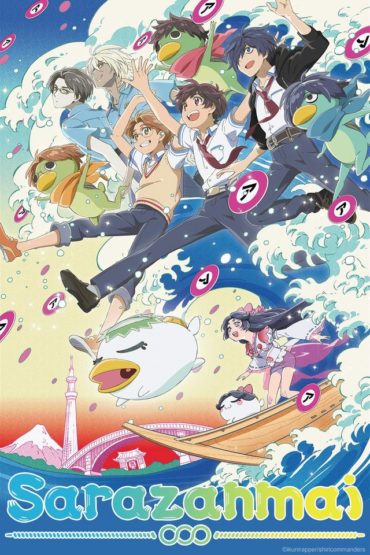Spring 2019 Streaming – Anime UK News Writers Take A First Look
With major changes in streaming on the horizon, we’ve been wondering if this 2019 Spring Season might be the last of Crunchyroll as we’ve known it? But with major new series Sarazanmai, Fruits Basket, One Punch Man Season 2 and Bungo Stray Dogs 3 all available (subbed) on Crunchyroll, it looks as if things aren’t so bad after all. Yet. And with Funimation providing many simuldubs and HIDIVE hanging in there, only Amazon Prime is looking decidedly disappointing with Dororo (excellent as it is) the only continuing new series on offer. Perhaps this situation will change…
Onosume:
We’re around three weeks into the Spring 2019 anime season as I write this, and so far, I’m finding this season to be rather lacklustre. Not that there isn’t some entertaining anime out there, but it definitely feels like we are in a lull at the moment.
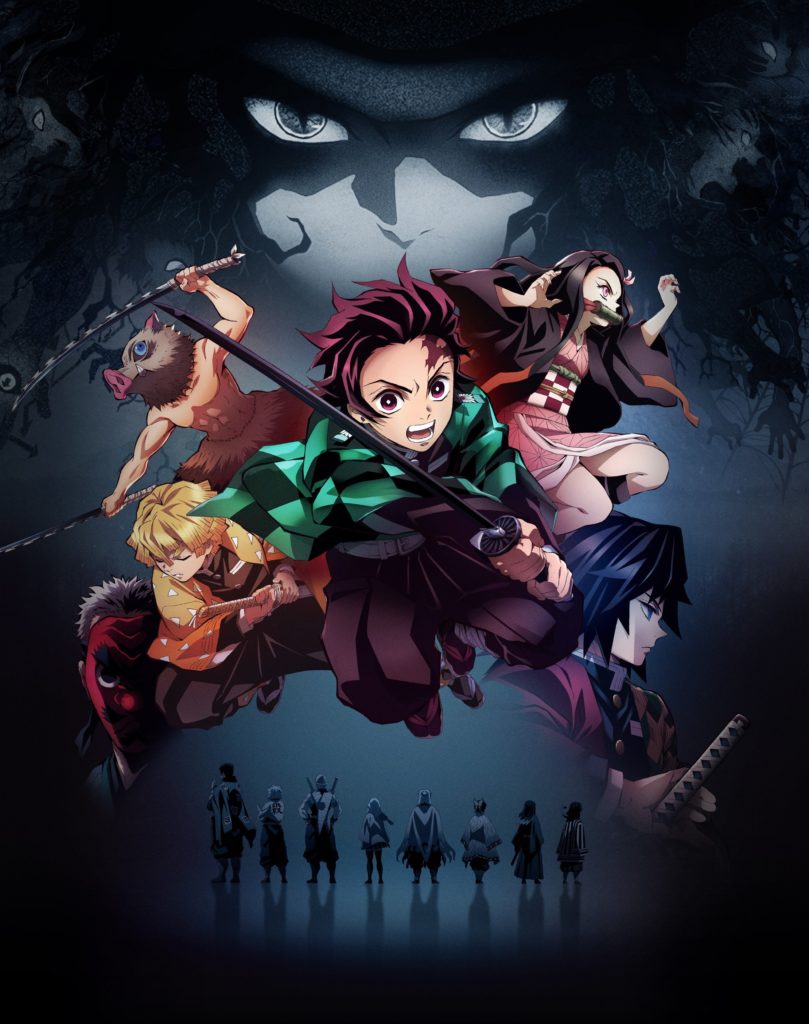
Sitting on top of the shows that have made a good impression on me this time around is Demon Slayer: Kimetsu no Yaiba.
Set in early-1900s Taisho-era Japan, the series focuses on Tanjirou, a teenage lad who lives with his family in the mountains, making a living selling coal to people in the small village below. During one trip to the village, he stays out too late and ends up hunkering down in a kind man’s house, as it is dangerous to stay out after dark. It soon becomes apparent why that is the case – Tanjirou returns home to find his family have been slain overnight by hungry demons, with his eldest sister being the only survivor. And it’s not just some horrific injuries that she’s been burdened with – after an encounter with a demon slayer, it’s revealed that she has actually been turned into a demon. Determined to defend his only remaining family member, Tanjirou resolves to become a demon slayer himself, hoping that in doing so he’ll find a way to return his sister to normal.
It may be the latest Shonen Jump series to find its way into anime but it’s not bad so far and it sets up its premise pretty well. Our protagonist, Tanjirou, obviously cares a lot for his family, and it’s made clear at this early stage at how powerless he is, yet there’s plenty of potential hidden away. The initial confrontation with the demon hunter shows that he’s pretty resourceful and has a good head for tactics, as he’s able to think on his feet and manoeuvre his enemy into a position where he has a slight advantage. Pair this with decent agility and you’ve definitely got a demon hunter in the making. His sister is also a wild card as, despite being a demon, she still recognises Tanjirou as one of her own, and her will to protect him gets her in on the fighting as well. If they can use her in combination with Tanjirou, I think it’ll open up her character and make good on having her not just as something to be protected.
Surprisingly for a Shonen Jump adaptation, this series has a lot of power in its animation thanks to ufotable, who bring their Type Moon expertise by making some very pretty looking snow. As they are well-known for their spectacular action sequences, I’m looking forward to see what they can do when they get serious with this one. So far it hasn’t been anything exceptional, but they pulled off the couple of fights we’ve had so far quite well, particularly with the flying hatchet shot in the first episode. I think a lot of people’s hopes have been raised by how good the opening animation looks, particularly in the way they have presented the elemental attacks in a very pop-looking ukiyo-e art style. If they’re able to use this in the show itself then this is going to look mighty impressive for a Shonen Jump series.
We’ll see how things go, but there does seem to be lots of potential with Demon Slayer; let’s just hope ufotable don’t squander this opportunity.

Out of this season’s two main healing, slice-of-life shows, I’m finding Hitoribocchi no Marumaru Seikatsu’s light comedy about a girl who struggles with social anxiety and making friends much more refreshing than The Helpful Fox Senko-san’s creepy, paedophilic overtones. The less said about the latter the better honestly, but with Hitoribocchi you’ve got a rather earnest slice-of-life show that actually isn’t uncomfortable despite it using something I’m sure many of us can relate to.
Perhaps it’s because of that that I’m finding it pleasing to watch, as protagonist Hitori makes earnest efforts to get to know and befriend her classmates and is positively rewarded for it. While I don’t quite like the unoriginal use of the term “Hitoribocchi” (“all alone”) as the main character’s name, nor the abrupt premise of her childhood friend cold-shouldering her until she makes friends with everyone in her class, the end goal is certainly one I can get behind. Thankfully, the girl whom she tries to befriend first, Sunao, is also a bit of a loner and is always messing around on her phone at break times rather than trying to interact with people. The two do seem to make quick friends of each other, and I find their interactions pretty amusing, particularly when it comes to certain humorous misunderstandings.
With a couple of other girls set to enter the fold, I’m definitely interested in seeing how Hitori integrates herself into the class and how the different character dynamics change over time. If you’re looking for a laid-back slice-of-life show that doesn’t take itself seriously this season, this is my recommendation for what to go for.
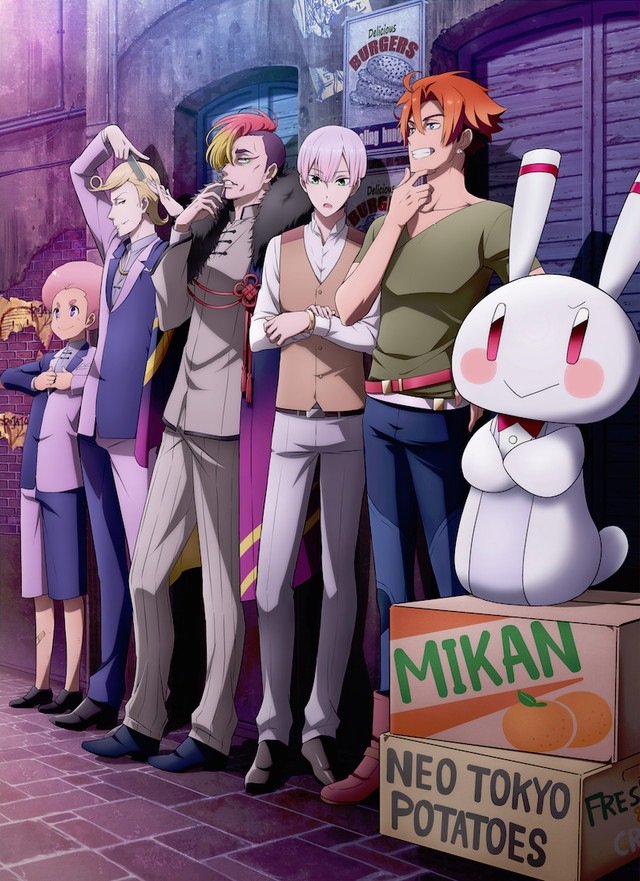
I’m sure many of you will have watched Shinichiro Watanbe’s epic space comedy Space Dandy a few years ago. Well, this season’s RobiHachi, produced by Studio Comet (most well-known for 2004’s School Rumble and more recently the children’s cartoon Jewelpet), is a bit of a Space Dandy wannabe, taking a lot of the core concepts of a hodgepodge gang travelling through space and getting into a series of misadventures.
RobiHachi’s lead, Robby, is a bit of a dreamer who could be doing a lot more in his life than hitting on girls and trying to take them to his spaceship/apartment, but doesn’t as a way to rebel against his rich, obnoxious family. Getting into debt with some ridiculous spending, he falls foul of debt collector Yang, who sends his subordinate, Hatchi, to make Robby pay up. After a series of events, Robby ends up on the run from Yang; thinking he can escape, Robby decides to head to Isekandar, a distant planet which is said to be able to fulfill your dreams if you go there. With Hatchi stuck in Robby’s ship and tagging along for the ride and Yang’s crew in hot pursuit, it does have an interesting set-up, although its first episode is rather slow to get started and fully establish its characters.
While it tries to do the same thing as Space Dandy, its initial attempts at trying to set up a buddy-cop comedy then switching tack to this madcap chase across space is a bit too much of a wild swing. I think it initially tries to take itself too seriously, particularly in comparison to Space Dandy, which was very up-front in what you were getting. I mean, you can’t get much more ridiculous than destroying the universe and killing off your main characters in the very first episode, can you? Once it gets going and brings in the super robot (meant to be a parody of Mazinger-Z), RobiHachi starts to hit home at what it wants to be, and solidifies itself more with its second episode set on Mars, where the Martians are hiding a certain secret that could spell doom for the Martian economy.
So, two episodes in, I get what the show is trying to do, but with Space Dandy having made its mark in this specific genre and story five years ago now, RobiHachi has a lot of work to do to prove it’s doing something significantly new. If it can’t, I fear it’ll just go down as a poor man’s rehash of Watanabe’s classic.
Demon Slayer: Kimetsu no Yaiba and Hitoribocchi no Marumaru Seikatsu are both streaming on Crunchyroll, while RobiHachi is streaming over on Funimation Now.
Cold Cobra:
The two series that stand out to me this season so far are two of the shows mentioned as having been snagged by Crunchyroll in this region, and thank goodness for that! So let’s start with Bungo Stray Dogs’ third season, shall we?

Bungo’s second season opened up with a multi-episode story arc set in the past, showing some important history that helped shape Dazai, one of our leads (or more specifically, the mentor to the main protagonist who quickly became far more interesting and liked than the actual protagonist…) into the person he is at the start of Season 1. Season 3 opens up with a similar premise. Once again the first few episodes have been set in the past, this time further back still, and focuses less on what made Dazai who he is but more on how he struck up a rocky friendship with Chuuya, someone who has appeared and been built up, but never fully explored so far. This obviously means the history between Dazai and Chuuya will undoubtedly be a key factor in whatever the plot of the rest of the present-set series is, but, regardless, it was once again anything but a waste of time.
The characters, especially Dazai, are great fun to follow, going from aloof teen obsessed with suicide (it’s funnier than it sounds…) to more intelligent and scheming member of the Port Mafia, and the animation is once again slick and blends 2D animation with a bit of CG flare perfectly. It may have nearly taken three years, but Bungo’s third season was worth the wait, and didn’t lose any quality in between seasons…
ahem Speaking of losing quality in between seasons…
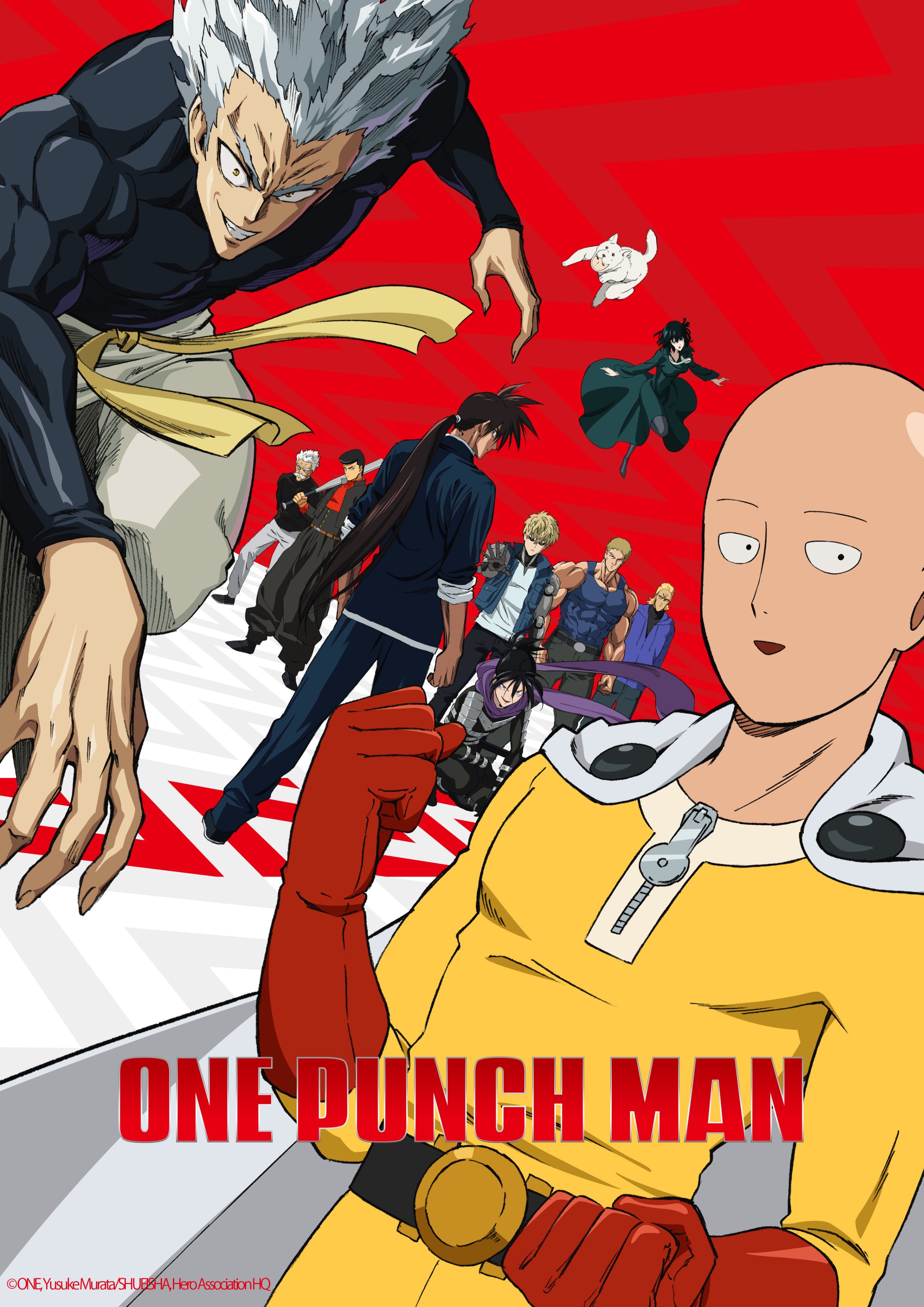
Yes, we all know about it by now, One Punch Man’s second season has been handled by a different animation company than Madhouse, who delivered the often mind-blowing original, and it definitely shows. I will say though that it isn’t that bad, it’s good actually, it’s just good after near-flawless makes the good seem far worse. As for the actual show itself? It’s thankfully still full of self-aware humour, plenty of action, and has started building up the next big threat in the very human-looking Garo. I could have done without the old Mr. Satan gag of having the Number 1 hero actually be a cowardly wimp who was in the right place at the right time, but his love of computer games and want to be left alone to play them is relatable, if nothing else! The rest of the regular cast from Season 1 haven’t slowed down either, Genos is the straight man who sets up and sells many of the gags about Saitama being the strongest hero but nobody knows it, and Sonic (the ninja, not the hedgehog) returned to once again get beaten effortlessly by our lead, but he showed off beforehand at least!
So while the show may not look at silky smooth and polished as it once did, it is offering the same laughs, action, and just like ONE’s other hit Mob Psycho 100, there is heart to the main character, just he’s the one teaching others, rather than learning them himself.
As mentioned at the top, Bungo Stray Dogs and One Punch Man are both streaming on Crunchyroll.
Demelza:
Spring is in full bloom and I’ve been eagerly awaiting the shows offered to us this season. Like Cold Cobra, I’ve been looking forward to the return of Bungo Stray Dogs for its third season and so far it hasn’t disappointed! Alongside The Rising of the Shield Hero, Fairy Tail and the return of Attack on Titan, I already have plenty to keep me entertained but even then I’ve found some new shows to fall in love with.

First up we have the anime adaption of Weekly Shonen Jump series, We Never Learn. As a dedicated follower of the manga I couldn’t wait to see the quirky and lovable cast in motion and so far the anime has being doing a good job of bringing the series to life. Our story follows Nariyuki Yuiga who has been working toward a scholarship to his chosen college. After months of hard work, Nariyuki’s wish is granted when the school headmaster offers him the scholarship – but there are conditions! In order to gain this scholarship once and for all, Nariyuki must tutor two of his fellow students: Rizu Ogata and Fumino Furuhashi. The two are geniuses, except for in the fields they wish to pursue and Nariyuki must figure out a way to bring them up to speed.
Like The Quintessential Quintuplets from last season, We Never Learn is here to offer an entertaining romantic comedy. Adapted in a collaboration between Studio Silver and Arvo Animation, the show has gotten off to a good start. The VAs are great and the animation is colourful, although it doesn’t quite offer the same range of entertaining expressions as the original manga does. For viewers with no prior knowledge of the manga, I think the anime has been cutting out a little bit too much in terms of character development, but it’s not bad enough to not be worth checking out regardless. Whereas those of us already well acquainted with the cast will have a wonderful time watching their antics play out week-to-week. Now if only my favourite character had been introduced already…

Next up we have Fairy Gone, a new original anime from studio P.A Works. The series follows the tale of Maria, a new recruit to the Dorothea organisation who are dedicated to the investigation of fairy-related crimes. Despite the world being at peace, the government is unstable after a recent war and many are out for revenge using the power of fairies. Together the members of Dorothea are out to put an end to these evil deeds.
Writing it out, it’s clear that the plot of Fairy Gone is fairly generic, but I have reason to believe in its potential. The writer behind the series is Ao Jumonji, author of Grimgar of Fantasy and Ash – a light novel series that captured the hearts of many. When I reviewed Grimgar’s anime adaption early last year I called it one of the best in the isekai genre and that’s something I stand by having continued to read the original light novels. With this in mind I’ve been excited for Fairy Gone, not willing to write it off despite a fairly mundane opening episode. Now at Episode 4, my patience has paid off as things begin to slot into place. It has been slow going but a lot of them stems from Jumonji’s writing. This is his first script for anime and it shows; it’s written more like a novel with the hooks much further into the show than you’d normally expect. Almost like the turning point 30-50~ pages into a novel, where you take a step back from the action to reflect on how we got to this point. It’s different and already turned people off the show, but I really think it’s worth spending more time with this one.
Being animated by P.A Works means the show looks beautiful. The studio have been using 3D to render the fairies, which is a real shame compared to how lovely the traditional 2D animation is otherwise, but this choice surprisingly works okay. It doesn’t feel as jarring as I was expecting it too. I also love that Fairy Gone, like Grimgar before it, sees (K)NoW_NAME handle the music side of things. The band offer a wonderful pop/rock based soundtrack that lifts up the action scenes and adds to the excitement. Their opening theme for the show, “Knock on the Core”, is catchy and hard to forget while ending “Ash Like Snow” is a slower, more sombre affair which works perfectly to close the show.
While Fairy Gone may not have gotten off to the best start for many it has become one of my favourite shows this season. With 24 episodes to play with, I’m looking forward to seeing how the story develops and although it’s likely to be a slow burner I think it’s worth sticking with. Jumonji is a great writer, coupled with a capable studio and musical team I think Fairy Gone could be quite special – eventually.

Oh, and before I go, I feel it’s worth giving a quick mention to Isekai Quartet. This series of 12 minute episodes brings together the cast of KonoSuba, Overlord, Re:Zero and The Saga of Tanya the Evil in a modern day high-school setting. While the KonoSuba cast are certainly the best suited to the whacky comedy that Isekai Quartet offers (and steal the show for a fan of theirs like me), the other three shows do well to live up to the drama the setting demands of them. Even if you’re only a fan of one or two of the shows included, Isekai Quartet won’t disappoint. At the very least there is nowhere else you will see Aqua try and purify Aniz Ooal Gown for being an undead skeleton…
We Never Learn is streaming on Crunchyroll, while Fairy Gone is on Funimation and Isekai Quartet is on both Funimation and Crunchyroll.
Sarah:

High schooler Tohru Honda has lost her mother – but finds a new home with some highly unconventional neighbours: three members of the Soma family: novelist Shigure and his younger cousins Yuki and Kyo. She also discovers their dark secret: they are all cursed – possessed – by the animal members of the Chinese zodiac and if anyone outside the family hugs them, they transform – only to transform back a little while later, stark naked. Kindly Tohru, working as their housekeeper to pay for her board and lodging, is drawn into their lives and soon her practical approach to life begins to bring about changes (for the better) in the chaotic bachelor household. However, the head of the Soma clan disapproves of this newcomer and her influence. Will Tohru be told to leave?
Fruit’s Basket Season 1 brings the beloved shojo manga by Natsuki Takaya back to life in a new (and much more faithful to the original in that it has the mangaka’s approval) version. Fond as I am of the original 2001/3 version, I’ve been enjoying the new one very much; apart from the advances in animation, it benefits from the manga being finished so that the dramatization has a flow and a balance that wasn’t possible in the first version. The Japanese cast is all-new but the US dub cast (Funimation) is using almost all of the original voice actors…

As a (resting!) musician, I’m always happy to discover another anime series in which music plays a significant role and Kono Oto Tomare!: Sounds of Life (Funimation) is looking promising so far. When his inspiring senpai graduate from high school, Kurata is left to keep the koto club going – not an easy task as the school delinquents like to play cards in the club room. The club is threatened with closure unless he can enrol more members, so unassuming yet dedicated megane Kurata is shocked when he gains an unexpected ally in the form of Chika Kudo, the school’s most feared delinquent. It turns out that, in spite of his fearsome reputation, Chika comes from a koto-making family. Then a new transfer student turns out to be koto-prodigy Satowa Hozuki – an attractive, talented girl with personality problems as she’s not used to working with others.
Kono Oto Tomare! has all the elements of a watchable teen drama plus added adult conflict with the genial head teacher who was friends with Chika’s dead grandfather pitted against the mean deputy who hates Chika and is determined that the club won’t succeed. Okay, it’s ever-so-slightly on the melodramatic side but every time someone plays a koto (or we get a taste of an ensemble playing together) the sound is compellingly magical. The glimpses we’re afforded of the way koto music is notated are fascinating as are the insights into how difficult an instrument it is to play. Just one minor problem: self-effacing, good-hearted Kurata should probably be the main focus, but with angsty characters like Chika and Hozuki already smouldering at each other, he’s constantly pushed into a supporting role. Well animated with attractive music, this series is worth checking out.
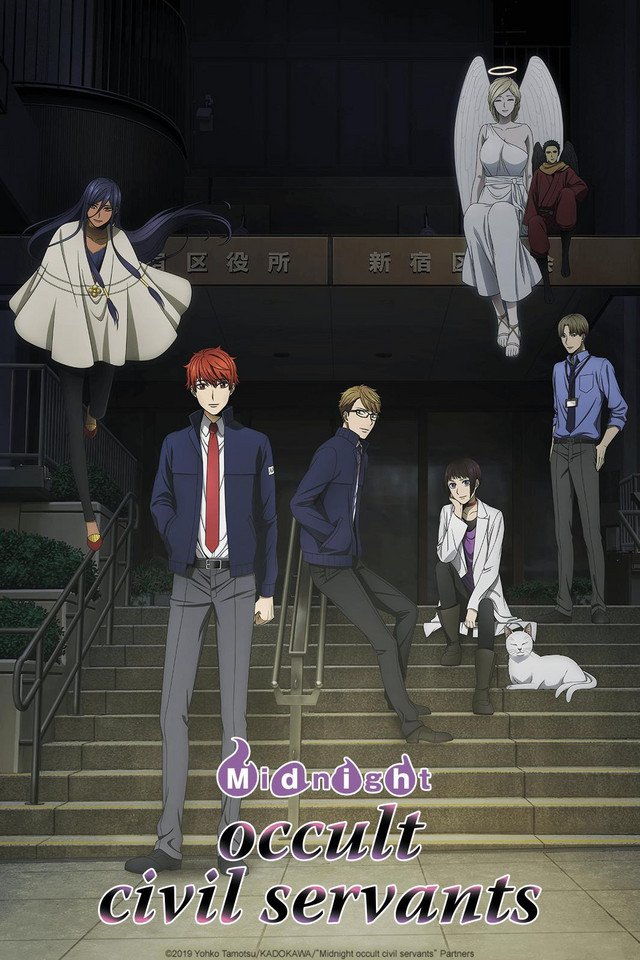
A quick mention for Midnight Occult Civil Servants (Crunchyroll) – such a neat title – which is sadly not at all well drawn or animated (except for the really stylish OP). The premise is exactly what it says in the title, with protagonist Arata joining the team of civil servants appointed to secretly police the Anothers, the supernatural inhabitants (tengu, angels, fairies etc.) of the city. However the fact that the intriguing storyline (and the underlying mixed folklore/historical background) can make you forget the relatively basic artwork as you watch is testament to its strengths – but the visual element is still disappointing. But I’ll happily watch anything with Abe no Seimei in it…
Which brings us to…Sarazanmai!
If you loved Revolutionary Girl Utena, were fascinated and intrigued by Mawaru Penguindrum or Yuri Kuma Arashi then you’ll be eager to follow Kunihiko Ikuhara’s latest anime series with its kappa, song and dance routines, shirikodama extraction (don’t ask!) LGBT+ themes, gay cops…and otters. Yes, otters. If you’re not a fan, then I guess you’ll be passing this by. Lynzee Loveridge’s article and Jacob Chapman’s reviews on ANN are so well-researched and detailed that I feel there’s little for anyone else to add right now. It’s a riot. I love it.
Kono Oto Tomare!: Sounds of Life is screening on Funimation; Fruits Basket and Midnight Occult Civil Servants can be found on both Crunchyroll and Funimation and Sarazanmai is currently on Crunchyroll.


